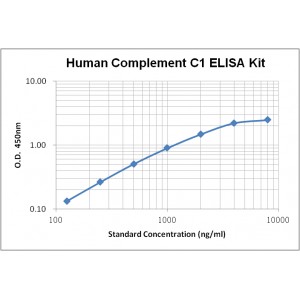More info
Assay Range | 125-8,000 pg/mL |
Sensitivity | 100 pg/mL |
Specificity | No cross-reaction with other related substances detected |
Size | 96T |
Storage | Store at 2 - 8ºC. Keep reconstituted standard and detection Ab at -20 ºC |
Assay Principle | Sandwich ELISA |
Sample Volume | 100 µL final volume, dilution factor varies on samples |
Detection Method | Chromogenic |
Kit Components
1. Recombinant Human C1 standard: 1 vial
2. One 96-well plate coated with Human C1 Ab
3. Diluent buffer (10x): 30 mL - 1
4. Biotinylated Human C1 Ab (100x): 80 µL
5. Streptavidin-HRP(100x): 80 µL
6. TMB developing agent: 8 mL x1
7. Stop solution: 12 mL x1
8. Washing solution (20x): 30 mL x2
Background
C1 is the first complement component in the classical pathway of complement. C1 binds to and is activated by antibodies bound to antigens (immune complexes) yielding a protease that initiates the cascade. C1 is actually a non-covalent complex of three different proteins (C1q, C1r and C1s) bound together in a calcium-dependent complex. The globular heads of the C1q bind to the Fc-fragment of IgM or IgG on the surface of a pathogen, resulting in the activation of C1r. The activated C1r is able to activate C1s which in turn activates C2 and C4, leading to the production of the C4b-C2a form of C3-convertase. C1 deficiency is generally associated with severe immune complex disease of systemic lupus erythematosus and glomerulonephritis.


